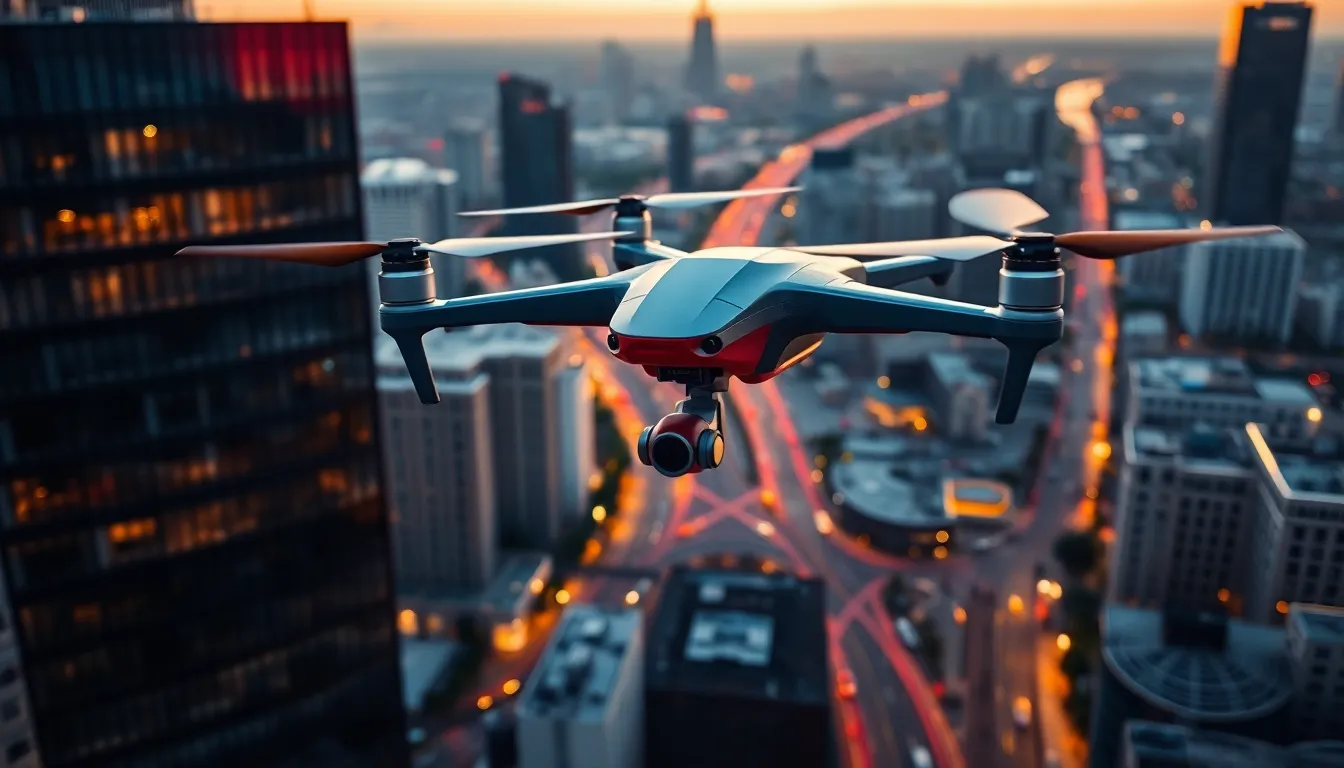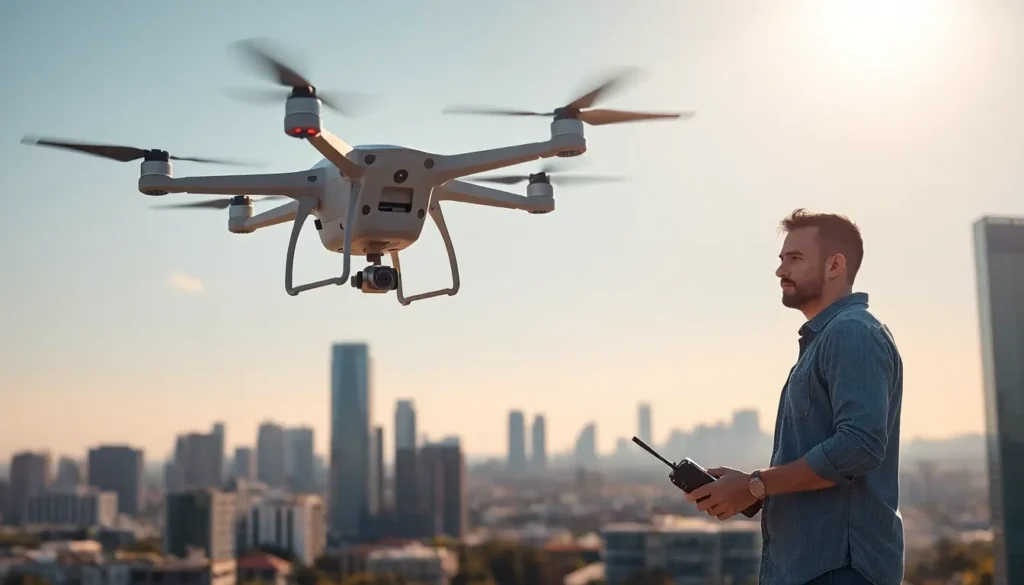Imagine a world where your delivery arrives faster than you can say “where’s my pizza?” Enter helicopter drones, the flying wonders that are transforming how we think about transportation and logistics. These high-flying gadgets don’t just hover; they swoop in with style, making traditional delivery methods look like they’re still stuck in traffic.
Table of Contents
ToggleOverview of Helicopter Drones
Helicopter drones represent a significant leap in the realms of transportation and logistics. Their innovative design allows for rapid item delivery, outperforming conventional methods in speed and efficiency.
Definition and Features
Helicopter drones, also known as multirotor drones, utilize rotating blades to lift and navigate. These drones feature various attributes including vertical takeoff and landing capabilities, advanced navigation systems, and robust payload capacities. Users can expect enhanced maneuverability and stability in diverse environments. Technologies such as GPS and obstacle avoidance systems elevate operational safety and effectiveness. Reliable communication systems ensure real-time data transmission between the drone and its operator.
Types of Helicopter Drones
Several types of helicopter drones cater to different applications. Commercial drones excel in package delivery and aerial photography. These drones often carry high-resolution cameras designed for surveying or inspection tasks. Industrial drones are built for heavy lifting, typically used in construction and infrastructure projects. Lastly, recreational drones provide a user-friendly experience for hobbyists and enthusiasts, offering features such as automated flight modes and intuitive controls. Each type addresses specific consumer needs within the growing market of drone technology.
Applications of Helicopter Drones

Helicopter drones serve various applications across multiple sectors, demonstrating versatility and innovation. Their capabilities transform how industries operate.
Commercial Uses
Commercial helicopter drones play a crucial role in package delivery and aerial photography. Many businesses use these drones to streamline logistics, reducing delivery times significantly. Retailers implement drone technology for speedy transport, reaching customers quickly in urban areas. Aerial photography evolves with drones, allowing photographers to capture stunning images from unique angles. Furthermore, filmmakers utilize helicopter drones to enhance cinematography, offering dynamic shots that elevate visual storytelling.
Military Uses
Military applications of helicopter drones focus on surveillance and reconnaissance. Armed forces deploy these drones for real-time intelligence gathering, enhancing mission effectiveness. Remote viewing minimizes risk to personnel during operations, enabling safer strategy execution. Troops utilize these drones for logistical support, delivering supplies to remote locations when conventional transport becomes challenging. Additionally, military exercises leverage drone capabilities for training simulations, preparing soldiers for diverse scenarios without endangering lives.
Advantages of Helicopter Drones
Helicopter drones offer numerous advantages that enhance various applications across industries. Their design and technology enable efficient operations in diverse environments.
Versatility and Maneuverability
Multirotor drones exhibit remarkable versatility, adapting to different tasks with ease. They perform well in various weather conditions, making them suitable for outdoor and indoor applications. Their vertical takeoff and landing capabilities simplify operations in tight spaces. Enhanced stability allows for high-resolution aerial photography and precise package delivery. Many helicopter drones also accommodate various payloads, including specialized equipment for different sectors. Businesses utilize these features to increase operational efficiency and reduce costs. Users can deploy them for inspections, agriculture, or search and rescue missions without extensive modifications. Overall, the adaptability of helicopter drones empowers seamless integration into various workflows.
Surveillance and Data Collection
Surveillance capabilities of helicopter drones provide real-time insights critical for various operations. These drones capture high-quality aerial imagery and video footage, enhancing situational awareness. Many industries depend on accurate data collection for environmental monitoring and infrastructure assessments. When conducting surveillance, helicopter drones cover vast areas quickly, which is invaluable for security and reconnaissance tasks. Advanced sensors, including thermal imaging and LIDAR, bolster their data collection capabilities. They assist military operations, construction site monitoring, and wildlife tracking, ensuring comprehensive analysis. Efficient data transmission from these drones allows stakeholders to make informed decisions rapidly. Consequently, the surveillance efficacy of helicopter drones accelerates response times and minimizes risks in critical situations.
Challenges and Limitations
Helicopter drones face several significant challenges and limitations that impact their widespread adoption. Regulatory frameworks often lag behind technological advancements, creating hurdles for operators.
Regulatory Issues
Regulatory challenges pose a major obstacle for helicopter drone deployment. Various agencies, including the Federal Aviation Administration (FAA), establish strict guidelines that govern airspace usage and safety standards. Compliance with these regulations can limit flight operations and restrict certain applications. Additionally, the approval process for commercial drone use involves lengthy applications and permits, which can delay projects. Operators must navigate these regulatory landscapes to ensure adherence to the evolving laws while maximizing operational efficiency.
Technical Limitations
Technical limitations also hinder helicopter drone performance. Battery life remains a critical constraint, with many models offering flight times ranging from 20 to 40 minutes per charge. Limited payload capacities restrict the types of cargo that can be transported, impacting their utility for heavier shipments. Additionally, adverse weather conditions can adversely affect flight stability and safety, leading to increased risk scenarios for pilots and equipment. Obstacles like signal interference and GPS inaccuracies further complicate drone navigation, underscoring the importance of ongoing technological advancements.
Future of Helicopter Drones
Helicopter drones are set to transform various industries further as technology evolves. Innovations in this field promise enhanced capabilities and broader applications.
Innovations in Technology
Advanced technology drives the future of helicopter drones. Improved battery life will enable longer flight durations, increasing functionality in critical tasks. Enhanced autonomous navigation systems offer more reliable operation in complex environments. Additionally, AI integration allows for smart decision-making, optimizing flight paths for efficiency. Lightweight materials increase payload capacities, supporting heavier cargo and diverse applications. Security features like encrypted communications reduce risks of hacking and data breaches. Every innovation enhances helicopter drones’ overall performance, meeting growing demands across sectors.
Market Trends
Market trends indicate significant growth in the helicopter drone sector. The commercial delivery segment is expanding rapidly as demand for faster logistics rises. Companies are investing heavily in drone technology to streamline operations and reduce costs. Consumer interest in recreational drones continues to climb, contributing to robust sales figures. Environmental concerns lead to increased research into sustainable battery technologies. Regulations are gradually becoming more supportive, allowing for easier integration into existing infrastructures. Each trend reflects a shift toward adopting helicopter drones as critical tools in modern operations.
Helicopter drones are reshaping the landscape of transportation and logistics with their impressive capabilities. Their ability to deliver items swiftly and efficiently makes them a game changer across various sectors. As technology continues to advance, these drones are expected to become even more integral to operations in commercial and military applications.
The ongoing development of battery technology and autonomous navigation systems promises to enhance their functionality further. As regulations evolve to support drone integration, businesses and consumers alike will benefit from the increased adoption of helicopter drones. Their versatility and efficiency are set to redefine how goods and services are delivered, paving the way for a more innovative future.

